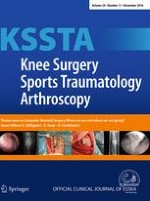01-11-2016 | Knee
Will a single periarticular lidocaine–corticosteroid injection improve the clinical efficacy of intraarticular hyaluronic acid treatment of symptomatic knee osteoarthritis?
Published in: Knee Surgery, Sports Traumatology, Arthroscopy | Issue 11/2016
Login to get accessAbstract
Purpose
A local injection of corticosteroid–lidocaine into the periarticular soft tissue structures is used commonly for rapid pain relief. It is hypothesized that knee pain associated with knee osteoarthritis would be relieved quickly and effectively in patients receiving intraarticular hyaluronic acid combined with a periarticular lidocaine–corticosteroid injection. To test this hypothesis, the clinical effect of the combined treatment with hyaluronic acid injection alone in patients with symptomatic knee osteoarthritis as compared in this prospective single-blinded randomized trial.
Methods
This study included 70 patients. Group 1 (n = 35) received intraarticular hyaluronic acid injections only, whereas group 2 (n = 35) received intraarticular hyaluronic acid injections combined with a single local injection of corticosteroid–lidocaine. Injections were administered to the most painful areas of the anterior or posterior medial condyle of the femur or tibia. The outcome was measured by independent assessors (blinded to treatment) using a linear VAS pain scale and WOMAC and HSS knee scores. Assessments were performed at baseline and at 1, 3, 6, 12, 26, and 52 weeks.
Results
During the first 3 weeks, group 2 patients showed significantly better all scores than did group 1 patients (p < 0.01). However, no significant differences were detected at 6, 12, 26 or 52 weeks (n.s.).
Conclusion
The combined treatment may lead to earlier pain relief compared with intraarticular hyaluronic acid alone in patients with knee osteoarthritis and can be considered a useful adjunctive treatment modality. This combined method may provide early return to patient’s daily activity.
Level of evidence
Therapeutic study, Level I.





